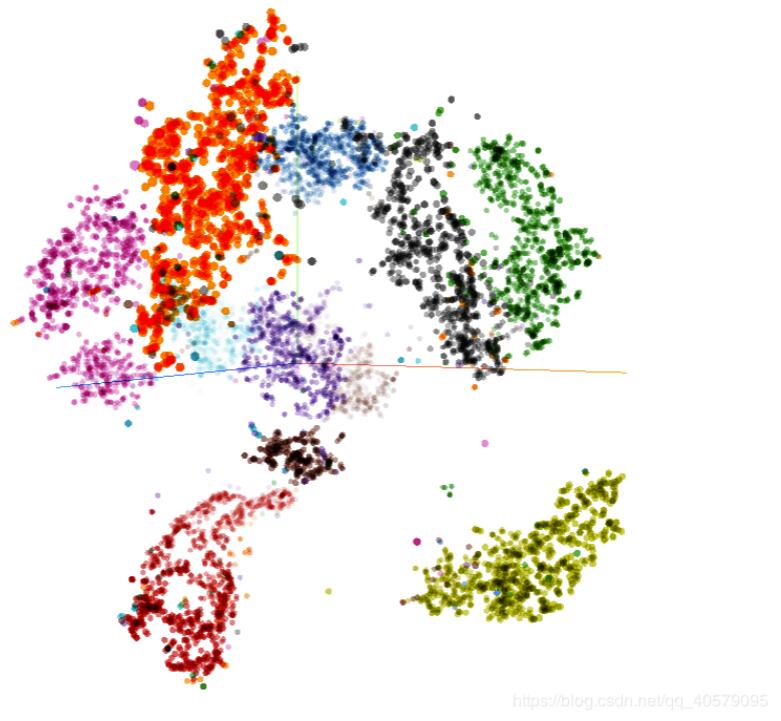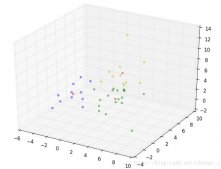本文實(shí)例為大家分享了基于Tensorflow的MNIST手寫數(shù)字識(shí)別分類的具體實(shí)現(xiàn)代碼,供大家參考,具體內(nèi)容如下
代碼如下:
|
1
2
3
4
5
6
7
8
9
10
11
12
13
14
15
16
17
18
19
20
21
22
23
24
25
26
27
28
29
30
31
32
33
34
35
36
37
38
39
40
41
42
43
44
45
46
47
48
49
50
51
52
53
54
55
56
57
58
59
60
61
62
63
64
65
66
67
68
69
70
71
72
73
74
75
76
77
78
79
80
81
82
83
84
85
86
87
88
89
90
91
92
93
94
95
96
97
98
99
100
101
102
103
104
105
106
107
108
109
110
111
112
113
114
115
116
117
118
119
120
121
122
123
124
125
126
127
128
129
130
131
132
133
134
135
136
137
138
139
140
141
142
143
144
145
146
147
148
149
150
151
|
import tensorflow as tfimport numpy as npfrom tensorflow.examples.tutorials.mnist import input_datafrom tensorflow.contrib.tensorboard.plugins import projectorimport timeIMAGE_PIXELS = 28hidden_unit = 100output_nums = 10learning_rate = 0.001train_steps = 50000batch_size = 500test_data_size = 10000#日志目錄(這里根據(jù)自己的目錄修改)logdir = 'D:/Develop_Software/Anaconda3/WorkDirectory/summary/mnist'#導(dǎo)入mnist數(shù)據(jù)mnist = input_data.read_data_sets('MNIST_data', one_hot = True) #全局訓(xùn)練步數(shù)global_step = tf.Variable(0, name = 'global_step', trainable = False)with tf.name_scope('input'): #輸入數(shù)據(jù) with tf.name_scope('x'): x = tf.placeholder( dtype = tf.float32, shape = (None, IMAGE_PIXELS * IMAGE_PIXELS)) #收集x圖像的會(huì)總數(shù)據(jù) with tf.name_scope('x_summary'): shaped_image_batch = tf.reshape( tensor = x, shape = (-1, IMAGE_PIXELS, IMAGE_PIXELS, 1), name = 'shaped_image_batch') tf.summary.image(name = 'image_summary', tensor = shaped_image_batch, max_outputs = 10) with tf.name_scope('y_'): y_ = tf.placeholder(dtype = tf.float32, shape = (None, 10))with tf.name_scope('hidden_layer'): with tf.name_scope('hidden_arg'): #隱層模型參數(shù) with tf.name_scope('hid_w'): hid_w = tf.Variable( tf.truncated_normal(shape = (IMAGE_PIXELS * IMAGE_PIXELS, hidden_unit)), name = 'hidden_w') #添加獲取隱層權(quán)重統(tǒng)計(jì)值匯總數(shù)據(jù)的匯總操作 tf.summary.histogram(name = 'weights', values = hid_w) with tf.name_scope('hid_b'): hid_b = tf.Variable(tf.zeros(shape = (1, hidden_unit), dtype = tf.float32), name = 'hidden_b') #隱層輸出 with tf.name_scope('relu'): hid_out = tf.nn.relu(tf.matmul(x, hid_w) + hid_b)with tf.name_scope('softmax_layer'): with tf.name_scope('softmax_arg'): #softmax層參數(shù) with tf.name_scope('sm_w'): sm_w = tf.Variable( tf.truncated_normal(shape = (hidden_unit, output_nums)), name = 'softmax_w') #添加獲取softmax層權(quán)重統(tǒng)計(jì)值匯總數(shù)據(jù)的匯總操作 tf.summary.histogram(name = 'weights', values = sm_w) with tf.name_scope('sm_b'): sm_b = tf.Variable(tf.zeros(shape = (1, output_nums), dtype = tf.float32), name = 'softmax_b') #softmax層的輸出 with tf.name_scope('softmax'): y = tf.nn.softmax(tf.matmul(hid_out, sm_w) + sm_b) #梯度裁剪,因?yàn)楦怕嗜≈禐閇0, 1]為避免出現(xiàn)無意義的log(0),故將y值裁剪到[1e-10, 1] y_clip = tf.clip_by_value(y, 1.0e-10, 1 - 1.0e-5)with tf.name_scope('cross_entropy'): #使用交叉熵代價(jià)函數(shù) cross_entropy = -tf.reduce_sum(y_ * tf.log(y_clip) + (1 - y_) * tf.log(1 - y_clip)) #添加獲取交叉熵的匯總操作 tf.summary.scalar(name = 'cross_entropy', tensor = cross_entropy) with tf.name_scope('train'): #若不使用同步訓(xùn)練機(jī)制,使用Adam優(yōu)化器 optimizer = tf.train.AdamOptimizer(learning_rate = learning_rate) #單步訓(xùn)練操作, train_op = optimizer.minimize(cross_entropy, global_step = global_step)#加載測試數(shù)據(jù)test_image = mnist.test.imagestest_label = mnist.test.labelstest_feed = {x:test_image, y_:test_label}with tf.name_scope('accuracy'): prediction = tf.equal(tf.argmax(input = y, axis = 1), tf.argmax(input = y_, axis = 1)) accuracy = tf.reduce_mean( input_tensor = tf.cast(x = prediction, dtype = tf.float32))#創(chuàng)建嵌入變量embedding_var = tf.Variable(test_image, trainable = False, name = 'embedding')saver = tf.train.Saver({'embedding':embedding_var})#創(chuàng)建元數(shù)據(jù)文件,將MNIST圖像測試集對(duì)應(yīng)的標(biāo)簽寫入文件def CreateMedaDataFile(): with open(logdir + '/metadata.tsv', 'w') as f: label = np.nonzero(test_label)[1] for i in range(test_data_size): f.write('%d\n' % label[i])#創(chuàng)建投影配置參數(shù)def CreateProjectorConfig(): config = projector.ProjectorConfig() embeddings = config.embeddings.add() embeddings.tensor_name = 'embedding:0' embeddings.metadata_path = logdir + '/metadata.tsv' projector.visualize_embeddings(writer, config) #聚集匯總操作merged = tf.summary.merge_all()#創(chuàng)建會(huì)話的配置參數(shù)sess_config = tf.ConfigProto( allow_soft_placement = True, log_device_placement = False)#創(chuàng)建會(huì)話with tf.Session(config = sess_config) as sess: #創(chuàng)建FileWriter實(shí)例 writer = tf.summary.FileWriter(logdir = logdir, graph = sess.graph) #初始化全局變量 sess.run(tf.global_variables_initializer()) time_begin = time.time() print('Training begin time: %f' % time_begin) while True: #加載訓(xùn)練批數(shù)據(jù) batch_x, batch_y = mnist.train.next_batch(batch_size) train_feed = {x:batch_x, y_:batch_y} loss, _, summary= sess.run([cross_entropy, train_op, merged], feed_dict = train_feed) step = global_step.eval() #如果step為100的整數(shù)倍 if step % 100 == 0: now = time.time() print('%f: global_step = %d, loss = %f' % ( now, step, loss)) #向事件文件中添加匯總數(shù)據(jù) writer.add_summary(summary = summary, global_step = step) #若大于等于訓(xùn)練總步數(shù),退出訓(xùn)練 if step >= train_steps: break time_end = time.time() print('Training end time: %f' % time_end) print('Training time: %f' % (time_end - time_begin)) #測試模型精度 test_accuracy = sess.run(accuracy, feed_dict = test_feed) print('accuracy: %f' % test_accuracy) saver.save(sess = sess, save_path = logdir + '/embedding_var.ckpt') CreateMedaDataFile() CreateProjectorConfig() #關(guān)閉FileWriter writer.close() |

以上就是本文的全部內(nèi)容,希望對(duì)大家的學(xué)習(xí)有所幫助,也希望大家多多支持服務(wù)器之家。
原文鏈接:https://blog.csdn.net/qq_40579095/article/details/88804019












